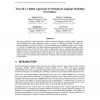283 search results - page 31 / 57 » Improving Statistical Word Alignment with Ensemble Methods |
CORR
1998
Springer
13 years 7 months ago
1998
Springer
Abstract. In many applications of natural language processing (NLP) it is necessary to determine the likelihood of a given word combination. For example, a speech recognizer may ne...
COLING
2010
13 years 2 months ago
2010
Previous works tend to compute the similarity between two sentences based on the comparison of their nearest meanings. However, the nearest meanings do not always represent their ...
COLING
2010
13 years 2 months ago
2010
In cross-language information retrieval it is often important to align words that are similar in meaning in two corpora written in different languages. Previous research shows tha...
JUCS
2006
13 years 7 months ago
2006
: Data assimilation is a method of combining an imperfect simulation model and a number of incomplete observation data. Sequential data assimilation is a data assimilation in which...
TALIP
2002
13 years 7 months ago
2002
This paper presents a unified approach to Chinese statistical language modeling (SLM). Applying SLM techniques like trigram language models to Chinese is challenging because (1) t...

